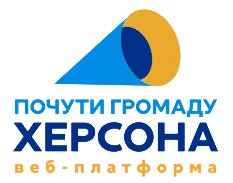Sociological Online Survey Report.
Methodology: An online survey using an interactive structured questionnaire; links to the survey were sent to potential respondents from the database (online research panel of the Kherson community). The sample was based on demographic indicators as of January 1, 2022. Given the indicators, the research margin of error does not exceed 5%, with a probability of 0.95. The sample included Kherson residents both currently residing within the community and those who left Kherson after February 24, 2022, to other regions of Ukraine or abroad. Currently, there is no official data on the
migration of Kherson’s residents, thus making it impossible to assess the given respondent sample’s representativity. However, there are reasons to believe that the ratio of those reporting themselves still residing within the community presented is greater than the actual ratio, which may affect the research results.
Research objective: to explore the dynamics of Kherson residents’ public opinion on acute issues in 2023–2024.
Sample scope: 455 respondents.
Field stage period: November 5 – 25, 2024.
Research client: Community Foundation of Kherson “Zakhyst”.
Key Findings
1.Over the previous year and a half,three top issues have been observed and recognized as the most acute problems in Kherson: difficulties with employment, non-transparent distribution of humanitarian aid, and stray animals.
2.However, in the November survey, the acuteness of these three issues somewhat decreased: by 9%, 4%, and 12%, respectively.
3.Kherson residents positively assessed the quality of most utilities services. This refers to gas, electricity, water supply, garbage pickup, and public cleansing. The elevator services were most conservatively estimated by Kherson residents.
4.Since July 2024, clothes and shoes, medicines, and building materials availability remains the most challenging issue for a third of Kherson residents. In November, the said indicators somewhat increased. Some respondents commented that this was due to the difficulties of traveling around the city as the security situation worsened.
5.With services, almost half (in November, 42%) of Kherson residents have difficulties traveling around the city by public transport, 36% – repairing consumer electronics, and 28% – building renovation. If compared to February 2024, the share of those who complained about internet access decreased twofold (from 43% to 24% in November).
6.Over a year and a half, there have been three issues that Kherson residents have had scarce information about: “where to address to get humanitarian aid,” “data on the local authorities’ activities” and “doctors’ schedules”. In November 2024, the number of those lacking information about the activities of local military administrations decreased by 9%, while the share of those wishing to know more about humanitarian aid increased by 6%. The ever increasing share of those requiring advice on compensation for their property damaged during the war has also grown somewhat.
7.The level of confidence in various institutions has not changed. This rating is topped by rescuers and the military, with local military administrations at the lowest. It should also be noted that the level of confidence in the city authorities, and mostly in the regional military administration, tends to be increasing.
8.When answering questions about the city’s recovery in four consecutive surveys, Kherson residents noted that the priority will be to restore destroyed buildings (67%), the work of medical institutions (55%), and industrial enterprises (49%). Compared to June 2024, the latter figure decreased by 14%. That said, only 10% believe the underground schools are adequate.
9.The most popular reasons Kherson residents stay in the city include one irrational one (“Kherson is my city, and I will not leave it under any circumstances” – 54%) and two rational ones: “I cannot afford an apartment rent in another city” – 51%, “I cannot leave my loved ones” – 45%.
10.Communication with family and friends has been the main way of escape for 57% of Kherson residents in these dark times. Thus, let’s not abandon one another.

You can read the full report by downloading it or read it in Ukrainian.
This research was conducted by the Zakhyst Kherson Community Foundation Charitable Organization as a part of its project implemented under the USAID/ENGAGE activity, which is funded by the United States Agency for International Development (USAID) and implemented by Pact. The consents of this research are the sole responsibility of Pact and its implementing partners and do not necessary reflect the views of USAID or the United States Government/
Reproducing and using any part of this product in any format, including graphic and electronic, copying or any other usage is suitable to reference to the sourc/




